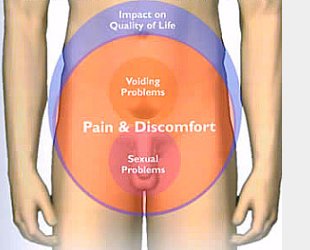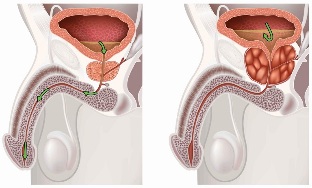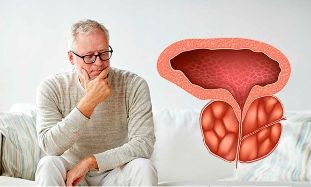Chronic prostatitis – long term side inflammation of the prostate gland, which leads to disturbances in the morphology and functioning of the prostate. Chronic prostatitis is manifested by prostate kind of triangle – the pain in the pelvis and genital area, urinary disorders, sexual disorders. Diagnosis of chronic prostatitis includes palpation of the gland, study of prostate secretion, ULTRASOUND, uroflowmetry, in, puncture biopsy of the prostate. Long-term exposure to inflammation of the prostate is shown in the comprehensive treatment, physiotherapy treatment, massage of the prostate, instillation posterior urethra. Surgical treatment is recommended when heavy forms of chronic inflammation of the prostate gland.
Chronic prostatitis

Chronic prostatitis – it is a common male disease: about 50% of men suffer from some form of inflammation of the prostate. Chronic prostatitis most commonly affects men aged 20 to 40 years, who in the period of greatest sexual, reproductive and work activities. In this regard, the diagnosis and treatment of chronic inflammation of the prostate gland is gaining in urology not only health, but also socially significant aspect.
Classification of chronic inflammation of the prostate
According to the modern classification of inflammation of the prostate, developed in 1995, issued 3 price groups of diseases:
- Also. Of acute prostatitis.
- II. Chronic prostatitis bacterial genesis.
- III. Chronic prostatitis nonbacterial genesis/Syndrome of chronic pelvic pain – a complex of symptoms, which is not in connection with the apparent symptoms of infection, and lasting from 3 months and more.
- III – chronic prostatitis with the presence of inflammatory components (detection of secret of the prostate gland leukocytes and infectious agents);
- III B – chronic prostatitis with the lack of inflammatory components (leukocytes and pathogens in the secret of the prostate gland).
- IV. Asymptomatic chronic prostatitis (lack of cues in the detection of leukocytes in prostatic secret).
In the presence of infectious components talking about bacterial (infectious) chronic inflammation of the prostate gland; in case of lack of microbial pathogens – nonbacterial (non-contagione) inflammation of the prostate gland. It is believed that 90-95% of all cases, has a place of non-bacterial chronic prostatitis, and only 10-5% - bacterial.
Causes of chronic inflammation of the prostate

The etiology and pathology of bacterial chronic prostate inflammation is linked with the intervention of the infection into the prostate gland in the following ways: increasing trend (through the urethra), downward (when the infected urine from the bladder), hematogenous (blood vessels of the arteries) or lymphogenous (the lymph collectors). More often uropathogens acts escherichia coli, Klebsiella, Proteus, staphylococcus, Enterococcus, CORINE, fungal, parasitic and viral pathogens. Together with the non-specific flora the development of chronic inflammation of the prostate may include representatives of specific urethritis (chlamydia, mycoplasma, gonococcus, Trichomonas, Gardnerella).
However, for the development of chronic inflammation of the prostate is important not so much the presence and activity of micro-organisms, how much the condition of the pelvic organs and blood circulation in them, the presence of comorbidities, the level of defense mechanisms.
Therefore, the occurrence of chronic inflammation of the prostate may contribute to a number of factors. Firstly, it is urological diseases –pyelonephritis, cystitis, urethritis, stricture of the urethra, increatos to the end of the acute prostatitis, orchitis, epididymitis, and other microbial, plant etiologist can fall in the prostate from remote foci of infection, for example in the presence of inflammation of the paranasal sinuses, tonsillitis, dental caries, chronic bronchitis, pneumonia, pyoderma and other Predispose to chronic inflammation, local and general hypothermia, overheating, stay in a humid environment, exhaustion, defective food, rare urination, etc.
Non-bacterial chronic prostatitis is usually associated with congestive (stagnant) phenomena in the prostate gland, due to stasis of the venous circulation in the pelvic organs and, violation of the outflow of the acini of the prostate. Local obstructio leads to the overflow of the blood vessels of the prostate the blood, the swelling, its incomplete emptying of secretion, disorders of the barrier, secretory, motor, contractile function of the gland.
Sluggish changes are usually caused by behavioural factors – prolonged sexual deprivation, the practice of open or prolonged sexual acts, excessive sexual activity, physical inactivity, lengthy and a seating area, chronic intoxication (alcohol, nicotine, drugs), professional hazards (vibration). To the development of nonbacterial chronic inflammation of the prostate gland predisposes pathology of the pelvic organs and neural structures, dealing with their innervation (e.g., spinal cord injury), adenoma of the prostate, hemorrhoids, constipation, androgenodeficiency, and other reasons.
Symptoms of chronic inflammation of the prostate
Chronic prostatitis is manifested by local and general symptomatology. Local manifestations include prostatic triad, which is characterized by pain, dysuria, and violation of sexual function. Pain in the chronic inflammation of the prostate gland are permanent aching in nature, localized in the area of the groin, genital area, above the pubis, in the groin. Painful is amplified at the beginning and at the end of urination, when this pain radiating to the head of the penis, the scrotum, sacrum, the rectum. Feelings of pain may increase after sexual intercourse or in connection with the long abstinence; to fall or to rise after the orgasm, the state vigorously directly to the point of ejaculation.
The intensity of the pain syndrome in chronic inflammation of the prostate differ from the sensations of discomfort in expression, which could disrupt sleep and functioning, manifestations. Pain with restricted localization in the sacrum is often considered to be degenerative disc disease or nerve, in connection with which the patient may long to treat yourself, without resorting to the help of a doctor.

Urination long-term exposure to inflammation of the prostate learning, and painful. While it may indicate a problem beginning miscet, weakening or intermittence of the jet of urine, feeling of incomplete emptying of the bladder, frequent night urination, burning in urethra. In the urine of long-term exposure to inflammation of the prostate can detect the presence of floating yarns. After a bowel movement or physical exertion of the urethra appear discharge , caused by a decrease in tone of the prostate. Long-term exposure to inflammation of the prostate may indicate the emergence of itching, feeling cold or sweating in the area of the perineum, local changes in skin colour, associated with the stagnation of blood circulation.
Chronic prostatitis is accompanied by pronounced disturbances of the sexual function. The phenomena of hypotension can be expressed in aggravation, soreness erection, long and frequent nighttime erections, hard or early ejaculation, loss of sexual desire (decreased libido), erased an orgasm, Hematospermias, infertility. Sexual disorders are always hard experienced man, which leads to psycho-emotional disorders, up to neurosis and depression, even more deterioration of sexual function.
Exacerbation of chronic inflammation of the prostate gland accompanied by a negligible increase in body temperature and deterioration of well-being. The overall condition of long-term exposure to inflammation of the prostate is characterized by increased by irritability, apathy, anxiety, rapid fatigue, loss of appetite, sleep disorders, reduced work ability, creative and physical activities.
Almost a quarter of the patients with chronic inflammation of the prostate symptoms of the disease a longer period of time is missing, which leads to a late conversion to the urologist. A longer period of time the chronic inflammation of the prostate can complicate impotence, vesiculitis, epididymoorchitis, male infertility, incontinence of urine, formation of stones and cysts of the prostate gland, sclerosis, prostate cancer, the development of adenoma and carcinoma of the prostate.
Diagnosis of chronic inflammation of the prostate
Necessary for the diagnosis of chronic inflammation of the prostate cancer information they get using the integrated laboratory-instrumental examination. The initial examination for suspected chronic prostatitis includes the findings of the medical history and complaints, conduct an external examination of the genitals on the subject of discharge, rashes, irritation, a digital rectal study of the prostate in order to determine the contours, boundaries, consistency, soreness of the glands.
For the determination of the structural and functional changes of the prostate is shown holding ULTRASONOGRAPHY of the prostate (TRUS). Important methods in the diagnosis of chronic inflammation of the prostate is used studies of prostate secretion, general urine analysis, bacteriological studies of the smear from urethra and urine, 3 cups of urine sample, PCR and REEF study scraping on the exciter genital infection, determination of prostate specific antigen (PSA).
Clinically significant long-term exposure to inflammation of the prostate gland serves as the identification in the analysis of the pathogens chlamydia, mycoplasmosis, herpes, cytomegalovirus, trichomoniasis, gonorrhea, candidiasis, as well as non-specific bacterial flora. Plot of secretion of the prostate for the warehouse is carried out after urination and to perform a prostate massage. Symptoms of chronic inflammation of the prostate gland serves to increase the number of leukocytes in the visual field, reducing the number of lecithin grains, the presence of pathogenic microflora.
In the overall analysis of urine in chronic inflammation of the prostate may be detected leukocyturia, pyuria, erythrocyturia. Bacteriological urine culture allows to reveal the degree and character of bacteriuria. When genital disorders is referred to the study donation of the sperm and the MAR-test.
The degree and causes of disorders of urination to help determine the urodynamic warehouse (uroflowmetry, cystometry, profilometry, electromyography). Using data from the research of chronic prostatitis is to be able to distinguish from stress incontinence of urine, neurogenic bladder, and al In hematuria, Hematospermias, obstructive urination is specified endoscopic examination - urethroscopy, cystoscopy. For the exclusion of adenoma and carcinoma of the prostate requires the definition of a DOG, in some cases – implementation of a prostate biopsy with morphological examines the tissue.

Treatment of chronic inflammation of the prostate
Chronic prostatitis is curable it is not easy, however, you must remember that recovery is still possible and largely depends on the attitude of the patient, the timeliness of his appeal to the specialist, the resolution of compliance with all the provisions of the urologist. The basis of treatment of chronic bacterial inflammation of the prostate gland is antimicrobial therapy, in accordance with antibiotics lasting no less than 2 weeks. To reduce the pain and inflammation, called NSAIDS ; for the relaxation of the muscles of the prostate, the restoration of urodynamics and of the outflow of the prostatic secret, shows the intake of a-adrenoblockers.
In order to improve the outflow of the prostate, local microcirculation and muscle tone is undergoing a course of therapeutic massage the prostate. Prostate massage should end the release of no less than 4 drops of the secretion of the prostate gland. Prostate massage is contraindicated in acute bacterial prostatitis, abscess of the prostate, hemorrhoids, stones of the prostate, cracks in the rectum, hyperplasia and prostate cancer.
For relieving the pain syndrome in chronic inflammation of the prostate may be recommended paraprostatic blockade, acupuncture. Of crucial importance in the treatment of chronic inflammation of the prostate included physiotherapy appointment of drugs, electrophoresis, ultrasound, phonophoresis, magnetic therapy, laser magneticam illic, inductometer, mud, SMT, hot sedentary bath at a temperature of 40 – 45°C, an enema with hydrosulphuric mineral water, instillations into the urethra.
In the development of complications associated with chronic inflammation of the prostate, is indicated surgical treatment: removal of the sharp criticism of the urethra; INSPECTION of the prostate or prostatectomy when sclerosis prostate; transurethral resection of the bladder in the sclerosis of his cervical puncture and drainage of cysts and abscesses of the prostate; circumcisio while phimosis, caused by recurrent infections of the urinary tract, etc.
Prevention of chronic inflammation of the prostate
Prevention of chronic inflammation of the prostate requires compliance with genital hygiene, timely therapy of the urogenital and extragenital infection, the normalization of the regularity of sexual life, insufficient physical activity, prevention of constipation, the timely emptying of the bladder.
For the avoidance of recurrence of the chronic inflammation of the prostate gland are necessary to the dynamic examination andrologist (urologist); preventive courses of physiotherapy, multivitamins, immunomodulators; exclusion of hypothermia, overheating, stress, bad habits.
























